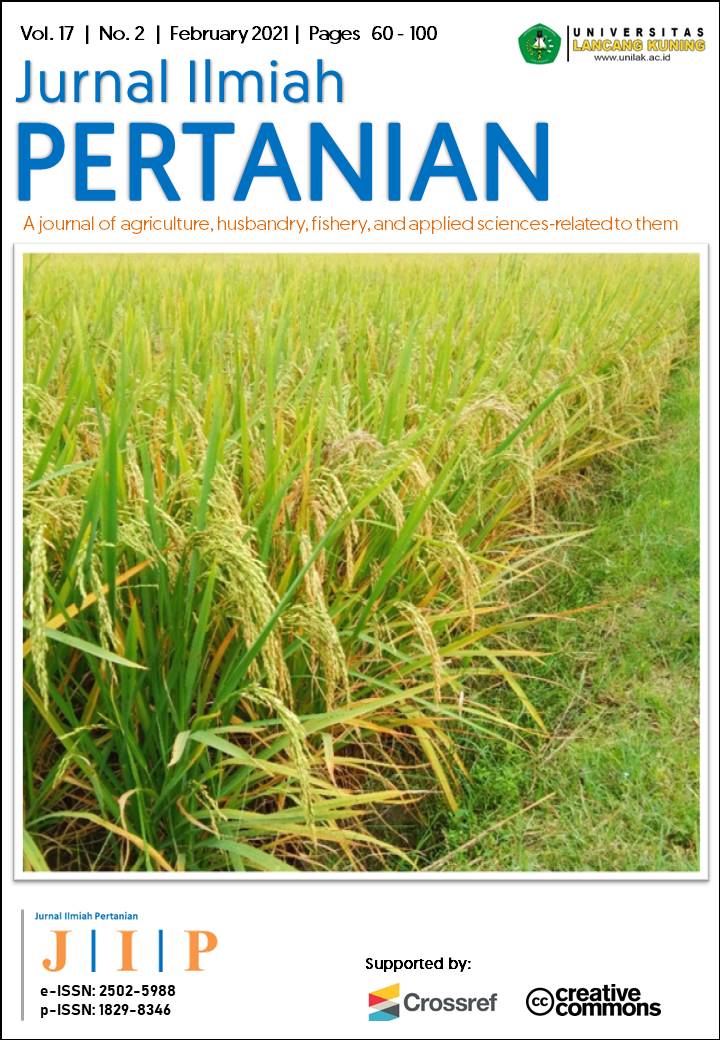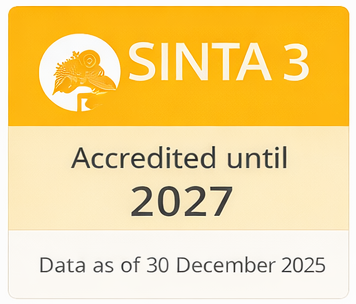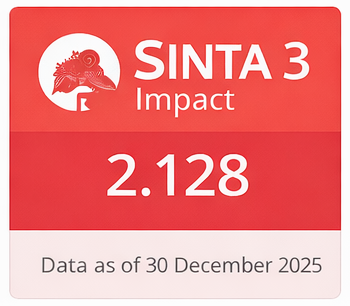Growth of celery (Apium graveolens L.) in the red-yellow podzolic soils as inoculated by earthworms Pontoscolex corethrurus
DOI:
https://doi.org/10.31849/jip.v17i2.5742Keywords:
celery, RYP soils, inoculation, earthworms, Pontoscolex corethrurusAbstract
In this study, the inoculation effect of earthworms Pontoscolex corethrurus on celery growth (Apium graveolens L.) has been carried out in red-yellow podzolic (RYP) soils. The research studied in a pot experiment using a completely randomized design (CRD) with 6 (six) treatments and 3 (three) replications. One-pot consists of 4 (four) plants. The treatments carried out were as follows: I0 (without inoculum of earthworm), I1 (inoculum of 5 earthworms pot-1), I2 (inoculum of 10 earthworms pot-1), I3 (inoculum of 15 earthworms pot-1), I4 (inoculum of 10 earthworms pot-1) and I5 (inoculum of 25 earthworms pot-1). Observation parameters were the number of tillers clumps-1, fresh biomass clumps-1 (g clump-1), and root volume (mL). The observations were statistically analyzed using variance (one-way ANOVA) and followed by the Duncan Multiple Range Test (DMRT) with a level of 5%. Treatment I5 gave the best results on celery crop in all parameters, i.e., 20.33 tillers per hill; fresh biomass per clump 113.93 g; and a root volume of 10 mL. The results showed that earthworms' inoculation into RYP soils significantly affected all parameters. There was also an increase in pH in each treatment that was inoculated with earthworms.
References
Adawiyah, R., & Afa, M. (2018). Pertumbuhan Tanaman Seledri (Apium graveolens L.) Pada Berbagai Media Tanam Tanpa Tanah Dengan Aplikasi Pupuk Organik Cair ( Poc ). Biowallacea, 5(1), 750–760.
Aladesida, A., Dedeke, G., Ademolu, K., & Museliu, F. (2014). Nutrient Analysis of Three Earthworm Cast-Types Collected From Ikenne, Ogun State, Nigeria. Journal of Natural Science, Engineering and Technology, March 2015, 36–43.
Anggraini, R. S., Zona, R. F., Candra, E., & Sutrisna, N. (2019). Model of organic fertilizer utilization made from local agricultural waste as soil fertilizer in Riau Province. Innovation of Environmental-Friendly Agricultural Technology Supporting Sustainable Food Self-Sufficiency, 2001, 503–510. https://doi.org/10.5281/zenodo.3345583
Ayten Karaca. (2011). Biology of Earthworms. Chapman & Hall.
Barbosa, J. Z., Demetrio, W. C., Silva, C. M., & Dionísio, J. A. (2017). Earthworms (Amynthas spp.) increase common bean growth, microbial biomass, and soil respiration. Semina:Ciencias Agrarias, 38(5), 2887–2898. https://doi.org/10.5433/1679-0359.2017v38n5p2887
Bongoua-Devisme, A. J., Akotto, O. F., Guety, T., Kouakou, S. A. A. E., Ndoye, F., & Diouf, D. (2019). Enhancement of phytoremediation efficiency of Acacia mangium using earthworms in metal-contaminated soil in Bonoua, Ivory Coast. African Journal of Biotechnology, 18(27), 622–631. https://doi.org/10.5897/ajb2019.16852
Duaja, M. D. (2019). Response of celery plant (Apium graviolens L.) to the reduction of inorganic fertilizer with decanter cake usage. Agric, 31(1), 31–40. https://doi.org/10.24246/agric.2019.v31.i1.p31-40
Fitri, K., Yaya, S., & Rina, N. (2019). The effect of planting media composition on the growth and yield of oyster mushrooms (Pleurotus ostreatus (Jack) P. Kumm. Media Pertanian, 4(2), 59–68.
Foller, R., & Silvina, F. (2017). The Effect of Growing Media Mix Peat With Red-Yellow Podzolik on the Growth of Seedlings of Oil Palm(Elaeis guineensis jacq) in the Main Nursery. JOM FAPERTA, 4(1).
García-Montero, L. G., Valverde-Asenjo, I., Grande-Ortíz, M. A., Menta, C., & Hernando, I. (2013). Impact of earthworm casts on soil pH and calcium carbonate in black truffle burns. Agroforestry Systems, 87(4), 815–826. https://doi.org/10.1007/s10457-013-9598-9
Infante, M. G., Guerrero, M. A., Vega, C. B., Demetrio, W. C., & Dionísio, J. A. (2018). Earthworms and Fusarium oxysporum: Effect on strawberry plant growth and production. Semina:Ciencias Agrarias, 39(4), 1437–1446. https://doi.org/10.5433/1679-0359.2018v39n4p1437
Khairan, K., Aulina, A., Bahi, M., Nova Eriana, C., & Sriwati, R. (2019). Fungicidal activity of garlic (Allium sativum) bulbs extracts against plants phatogenic fungi. Jurnal Hama Dan Penyakit Tumbuhan Tropika, 19(1), 23. https://doi.org/10.23960/j.hptt.11923-32
Kooti, W., & Daraei, N. (2017). A Review of the Antioxidant Activity of Celery (Apium graveolens L). Journal of Evidence-Based Complementary and Alternative Medicine, 22(4), 1029–1034. https://doi.org/10.1177/2156587217717415
Lidar, S., & Surtinah, S. (2020). Plant Response Due to Inoculation of Fr.Mull Earthworm (Pontoscolex Corethrurus): Pakchoy (Brassica Rapa L) Context. IOP Conference Series: Earth and Environmental Science, 469(1). https://doi.org/10.1088/1755-1315/469/1/012019
Lv, M., Fu, S., Shao, Y., Lin, Y., Wu, J., & Zhang, W. (2020). Earthworm Pontoscolex corethrurus stimulated soil CO2 emission by enhancing substrate availability rather than changing microbiota community structure. Science of the Total Environment, 717, 137227. https://doi.org/10.1016/j.scitotenv.2020.137227
Lv, M., Shao, Y., Lin, Y., Liang, C., Dai, J., Liu, Y., Fan, P., Zhang, W., & Fu, S. (2016). Plants modify the effects of earthworms on the soil microbial community and its activity in a subtropical ecosystem. Soil Biology and Biochemistry, 103, 446–451. https://doi.org/10.1016/j.soilbio.2016.09.020
Malhotra, S. K. (2006). Celery. In Handbook of herbs and spices (pp. 317–336). http://www.sciencedirect.com/science/article/pii/B978184569017550018X
Ngosong, C., Nfor, I., Tanyi, C., Olougou, M., Sone, K., Agbor, D., Ndakwe, A., Nanganoa, L., & Tening, A. (2020). Effect of poultry manure and inorganic fertilizer on earthworm population and soil fertility: implication on root nodulation and yield of climbing bean (Phaseolus vulgaris). Fundamental and Applied Agriculture, 5(0), 1. https://doi.org/10.5455/faa.76612
Nurhidayati, N., Ali, U., & Murwani, I. (2016). Yield and Quality of Cabbage (Brassica oleracea L. var. Capitata) Under Organic Growing Media Using Vermicompost and Earthworm Pontoscolex corethrurus Inoculation. Agriculture and Agricultural Science Procedia, 11, 5–13. https://doi.org/10.1016/j.aaspro.2016.12.002
Pande, S. K., Chaubey, A. N., Singh, V., & Pal, K. (2017). Eco-friendly management of cercospora leaf spot (cercospora rauvolfia) of sarpgandha. Plant Archives, 17(1), 546–548.
Purnama, I., Malhat, F., Jaikaew, P., & Ahmed, T. (2015). Toxicological & Environmental Chemistry Degradation profile of azoxystrobin in Andisol soil : laboratory incubation. May, 37–41. https://doi.org/10.1080/02772248.2015.1015297
Rupasinghe, H. P. V. (2020). Special Issue “Flavonoids and Their Disease Prevention and Treatment Potential”: Recent Advances and Future Perspectives. Molecules, 25(4746), 1–7.
Sanchez-Hernandez, J. C., Ro, K. S., & Díaz, F. J. (2019). Biochar and earthworms working in tandem: Research opportunities for soil bioremediation. Science of the Total Environment, 688(June), 574–583. https://doi.org/10.1016/j.scitotenv.2019.06.212
Sharma, D. K., Tomar, S., & Chakraborty, D. (2017). Role of earthworm in improving soil structure and functioning. Current Science, 113(6), 1064–1071. https://doi.org/10.18520/cs/v113/i06/1064-1071
Shawky, E., Nada, A. A., & Ibrahim, R. S. (2020). Potential role of medicinal plants and their constituents in the mitigation of SARS-CoV-2: Identifying related therapeutic targets using network pharmacology and molecular docking analyses. RSC Advances, 10(47), 27961–27983. https://doi.org/10.1039/d0ra05126h
Sinha, R. (2011). Organic Farming by Vermiculture: Producing Safe, Nutritive and Protective Foods by Earthworms (Charles Darwin’s Friends of Farmers). American Journal of Experimental Agriculture, 1(4), 363–399. https://doi.org/10.9734/ajea/2011/519
Sizmur, T., & Hodson, M. E. (2009). Do earthworms impact metal mobility and availability in soil? - A review. Environmental Pollution, 157(7), 1981–1989. https://doi.org/10.1016/j.envpol.2009.02.029
Sowbhagya, H. B. (2014). Chemistry, Technology, and Nutraceutical Functions of Celery (Apium graveolens L.): An Overview. Critical Reviews in Food Science and Nutrition, 54(3), 389–398. https://doi.org/10.1080/10408398.2011.586740
Sri, H., & Karnilawati. (2018). Karakterisasi dan klasifikasi tanah Ultisol di Kecamatan Indrajaya Kabupaten Pidie. Jurnal Ilmiah Pertanian, 14(2), 52–59.
Sumpena, U., & Permana, A. (2020). Budidaya seledri menggunakan pot/polybag. Balai Penelitian Tanaman Sayuran. http://balitsa.litbang.pertanian.go.id/ind/images/Isiposter/MP-29Budidayaseledri-KRPL.pdf
Thakur, S., Mayank, Sarkar, B., Ansari, A.J, Khandelwal, A. Arya, A., Poduri, & R., Joshi, G. (2020). Exploring the magic bullets to identify Achilles’ heel in SARS-CoV-2: Delving deeper into the sea of possible therapeutic options in Covid-19 disease: An Update. Food and Chemical Toxicology.
Vidal, A., Watteau, F., Remusat, L., Mueller, C. W., Nguyen Tu, T. T., Buegger, F., Derenne, S., & Quenea, K. (2019). Earthworm cast formation and development: A shift from plant litter to mineral associated organic matter. Frontiers in Environmental Science, 7(APR), 1–15. https://doi.org/10.3389/fenvs.2019.00055
Vodounnou, D. S. J. V., Kpogue, D. N. S., Tossavi, C. E., Mennsah, G. A., & Fiogbe, E. D. (2016). Effect of animal waste and vegetable compost on production and growth of earthworm (Eisenia fetida) during vermiculture. International Journal of Recycling of Organic Waste in Agriculture, 5(1), 87–92. https://doi.org/10.1007/s40093-016-0119-5
Wu, J., Zhang, C., Xiao, L., Motelica-Heino, M., Ren, Z., Deng, T., & Dai, J. (2020). Impacts of earthworm species on soil acidification, Al fractions, and base cation release in a subtropical soil from China. Environmental Science and Pollution Research, 27(27), 33446–33457. https://doi.org/10.1007/s11356-019-05055-8
Wu, Y., Wu, J., Ma, Y., Lian, Y., Sun, H., Xie, D., Li, Y., Brookes, P. C., & Yao, H. (2019). Dynamic changes in soil chemical properties and microbial community structure in response to different nitrogen fertilizers in an acidified celery soil. Soil Ecology Letters, 1(3–4), 105–113. https://doi.org/10.1007/s42832-019-0012-z














